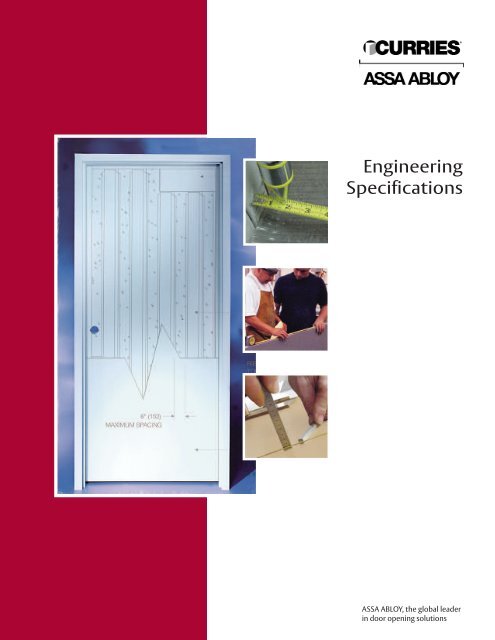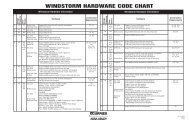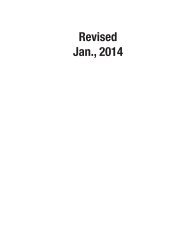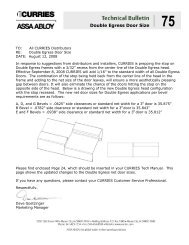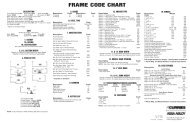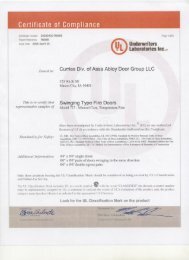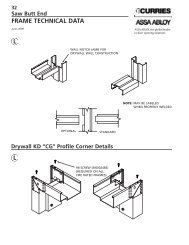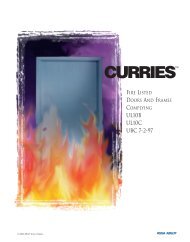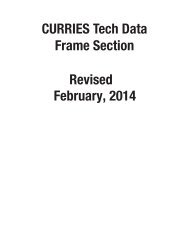Engineering Specifications Brochure - Curries
Engineering Specifications Brochure - Curries
Engineering Specifications Brochure - Curries
Create successful ePaper yourself
Turn your PDF publications into a flip-book with our unique Google optimized e-Paper software.
<strong>Engineering</strong><br />
<strong>Specifications</strong><br />
ASSA ABLOY, the global leader<br />
in door opening solutions
Index<br />
ENGINEERING SPECIFICATION SHEET - GENERAL INFORMATION ........................................................................................................1<br />
707 DOOR SERIES PHYSICAL PERFORMANCE ........................................................................................................................................2-3<br />
Surface Load Test<br />
Sag Test<br />
Racking Twist Test<br />
Beam Test<br />
Compression Load Test<br />
CHANNEL REINFORCING PERFORMANCE CHARACTERISTICS ..............................................................................................................4<br />
Channel vs. Plate Reinforcing Section Properties Comparison<br />
Hinge Channel Reinforcing #12-24 Thread Pullout Strength<br />
STEEL SPECIFICATIONS ....................................................................................................................................................................................5-6<br />
ASTM Steel <strong>Specifications</strong><br />
Types of Zinc-Coating<br />
Coating Designations<br />
Minimum Coating Weights<br />
Average Coating Thickness<br />
INSULATION FACTORS - THERMAL PERFORMANCE ..................................................................................................................................7<br />
Thermal Performance Test Results<br />
Energy Efficient Solutions<br />
INSULATION FACTORS - CORE MATERIALS ..............................................................................................................................................8-9<br />
Polystyrene Coreboard Material <strong>Specifications</strong> (607, 707, 737)<br />
Polyurethane (Polyisocyanurate) Coreboard Material <strong>Specifications</strong> (707)<br />
Fire Door Temperature Rise Coreboard Material <strong>Specifications</strong> (727)<br />
Thermal Resistant Glass Fiber Insulation Material <strong>Specifications</strong> (747, 777)<br />
Thermal Resistant Mineral Wool Insulation (747 Temperature Rise)<br />
Honeycomb Core Material <strong>Specifications</strong> (707)<br />
SOUND TRANSMISSION...................................................................................................................................................................................10<br />
Sound Transmission Loss Performance Test Results<br />
PAINT SPECIFICATIONS ....................................................................................................................................................................................11<br />
Surface Preparation<br />
Pre-Treatment<br />
Prime Paint Tests<br />
Door/Frame Prime Paint Properties<br />
WIND STORM PRODUCT ..................................................................................................................................................................................12<br />
SECURITY PRODUCT ........................................................................................................................................................................................13<br />
Commercial Security Hollow Metal Doors and Frames
General Information<br />
General:<br />
The <strong>Engineering</strong> Specification Sheets have been developed to provide a technical description of CURRIES’ products.<br />
Every effort has been made to insure the accuracy of the information. CURRIES Company reserves the right to revise<br />
these specifications without notification as new tests are conducted, tests or specifications are revised, and as new<br />
products are introduced.<br />
Please contact the CURRIES Customer Service Department if any errors, omissions, or questions are identified.<br />
NOTE: Information included in this data sheet is proprietary to CURRIES Company and subject to revision<br />
without notification.<br />
1
707 Door Series Physical Performance<br />
Surface Load Test<br />
Pressure was applied across a 707 series door installed in a test frame and deflection was recorded to<br />
determine maximum surface load achieved.<br />
Surface Bottom Door Center Door<br />
Load (lb/ft2) Deflection (in) Deflection (in)<br />
720 0.005 0.050<br />
1,440 0.250 1.406<br />
1,585 0.269 1.406<br />
1,730* 0.288 1.406<br />
2,300 -- --<br />
* 2300 lb/ft2 was achieved but could not be sustained long enough<br />
for deflection reading.<br />
Sag Test<br />
A downward force was applied at the lock edge top corner of a 707 series door installed in a test frame. Deflection was<br />
recorded between frame and top hinge location to determine maximum corner loading<br />
prior to hinge reinforcement failure.<br />
Load (lb) Deflection (in)<br />
1,000 0.05<br />
1,600 0.12<br />
2,200 0.23<br />
3,000 0.5<br />
3,400 0.7<br />
4,000* 1.02<br />
* Top hinge screw threads stripped out after approximately 1 minute at load.<br />
NOTE: Information included in this data sheet is proprietary to CURRIES Company and subject to revision<br />
without notification.<br />
2
707 Door Series Physical Performance<br />
Racking Twist Test<br />
Three corners of a 707 series door were supported and a load was applied to the unsupported corner. Deflection was<br />
measured to determine maximum rack load achieved.<br />
Load (lb)<br />
Deflection (in)<br />
200 0.25<br />
550 0.75<br />
650 0.95<br />
700 1.05<br />
900 1.75<br />
1050* 2.8<br />
* Maximum sustainable load, 1.95” permanent deflection.<br />
Beam Test<br />
The ends of a 707 series door were supported across the width and a load was applied in the center. Deflection was measured<br />
to determine maximum load achieved.<br />
Load (lb) Deflection (in)<br />
500 0.111<br />
700 0.156<br />
1,000 0.228<br />
1,500 0.342<br />
2,000* 0.489<br />
* Maximum sustainable load<br />
Compression Load Test<br />
A 707 series door samples was compressed to determine deflection achieved at varying compressive loads.<br />
Compressive<br />
Load (lb) Deflection (in)<br />
30,000 0.16<br />
35,000 0.51<br />
55,000 0.91<br />
75,000 1.3<br />
100,000 1.46<br />
NOTE: Information included in this data sheet is proprietary to CURRIES Company and subject to revision<br />
without notification.<br />
3
Channel Reinforcing<br />
Performance Characteristics<br />
Channel vs. Plate Reinforcing Section Properties Comparison<br />
A comparison of the section properties (tension, compression, and flexure) of channel type (3/4” x 1.625”)<br />
and flat bar (1-1/4”) reinforcing was performed. The u-channel reinforcing used in CURRIES’ hollow metal doors<br />
exhibits superior properties to that of the flat bar reinforcing.<br />
% Increase in % Increase in % Increase in % Increase in<br />
Channel vs. Compression and in Fracture Flexure Flexure<br />
Plate Yielding Tension Tension (Perpendicular) (Parallel)<br />
14 ga. vs. 10 ga. 32 36 2,100 395<br />
12 ga. vs. 7 ga. 38 41 1,550 407<br />
Hinge Channel Reinforcing #12-24 Thread Pullout Strength<br />
Screw pullout testing has been performed on CURRIES’ 12 and 14 gauge channel with extruded hole,<br />
12 and 7 gauge flat, and 14 gauge flat double thickness to determine relative thread strength.<br />
Results*<br />
Sample (lb) Observations<br />
12 gauge channel with extruded hole 1,840 Fastener pulled apart, screw still operable in sample<br />
12 gauge flat 1,240 Thread stripped off end of fastener<br />
7 gauge flat 1,910 Fastener pulled apart, screw still operable in sample<br />
14 gauge channel with extruded hole 1,250 Channel distorted before threads failed<br />
14 gauge flat double thickness 1,320 Material distorted and thread failed<br />
*Average of three samples tested.<br />
The 14 gauge channel’s extruded hole threads are stronger than the parent metal or the fastener. The<br />
results listed are for a single screw hole. A hinge that is mounted to a 14 gauge hinge channel has a<br />
combined strength of 5000 lbs ((1,250lbs/screw)*(4 screws/hinge)).<br />
NOTE: Information included in this data sheet is proprietary to CURRIES Company and subject to revision<br />
without notification.<br />
4
Steel <strong>Specifications</strong><br />
ASTM Steel <strong>Specifications</strong><br />
CURRIES manufactures products from steel meeting applicable ASTM specifications that are listed in ANSI A250.8.<br />
Cold rolled, hot rolled, galvanized, galvannealed, and stainless steel products are summarized in the table below:<br />
A480/A480M<br />
A568/A568M<br />
A653/A653M<br />
A924/A924M<br />
A1008/A1008M<br />
A1011/A1011M<br />
CURRIES’ Product Uses Material Gauge Steel Type ASTM Designation<br />
Doors and Reinforcements 20, 18, 16, 14, 12 Cold Rolled A1008/A1008M<br />
Frames 18, 16, 14, 12 A568/A568M<br />
E1 Coverbox w/Integral Tabs 16 A1008/A1008M<br />
Reinforcing 11, 7 Hot Rolled A568/A568M<br />
Door Hinge/Lock Channels 14, 12, 10 A1011/A1011M<br />
Doors 20, 18, 16, 14, Galvanized A653/A653M<br />
Frames 16, 14,12 G90<br />
Doors 20, 18, 16, 14, Galvannealed A653/A653M<br />
Frames 18, 16, 14, 12 A60 A924/A924M<br />
Snap-In Top Caps 24<br />
Doors 20, 18, 16 Stainless Steel A480/A480M<br />
Frames 18, 16, 14 #304<br />
Types of Zinc-Coating<br />
Specification for General Requirements for Flat-Rolled Stainless and Heat-Resisting Steel Plate, Sheet, and Strip.<br />
Specification for Steel, Sheet, Carbon, and High-Strength, Low-Alloy, Hot-Rolled and Cold-Rolled Sheet, General Requirements for<br />
Specification for Steel Sheet, Zinc-Coated (Galvanized) or Zinc-Iron Alloy-Coated (Galvannealed) by the Hot Dip Process.<br />
Specification for General Requirements for Steel Sheet, Metallic-Coated by the Hot-Dip Process.<br />
Specification for Steel, Sheet, Cold-Rolled, Carbon, Structural, High-Strength Low-Alloy and High-Strength Low-Alloy with<br />
Improved Formability.<br />
Specification for Steel, Sheet and Strip, Hot-Rolled, Carbon, Structural, High-Strength Low-Alloy and High-Strength Low Alloy with<br />
Improved Formability.<br />
Zinc-coated steel doors and frames are fabricated from steel that has been zinc-coated by the “Hotdip” process. This process<br />
consists of submerging the steel in a bath of molten zinc. As the steel emerges various means are used to level and control the<br />
thickness of the zinc-coating to achieve a specific coating weight.<br />
The zinc-coating produced from this method consists of an iron-zinc alloy layer with spangles of free zinc sitting on the surface.<br />
This type of coating is referred to with a G designation. If the steel is subjected to an additional annealing (heat treating)<br />
step the result is a completely alloyed iron-zinc coating referred to with an A designation. Both the A and G designations are a<br />
hot-dipped galvanized coating.<br />
Coating Designations<br />
Coating designations are written to represent the coating type, either G or A, and the coating weight. The coating weight is the<br />
amount of zinc on the steel surface and is expressed to represent the ounces per square foot of zinc as the total weight on<br />
both surfaces of the steel sheet.<br />
Although sometimes specified, the zinc-coating designation G90 or greater is not recommended for door and frame construction.<br />
In addition to the limited availability of this material, the heavier coating causes problems<br />
in the fabrication process during forming, welding, and painting operations.<br />
Minimum Coating Weights<br />
In a coating weight of 40 there is an average of 0.4 ounces of zinc per square foot of steel, in 60 there is an average of 0.6 ounces of<br />
zinc per square foot of steel, and in 90 there is an average of 0.9 ounces of zinc per square foot of steel.<br />
NOTE: Information included in this data sheet is proprietary to CURRIES Company and subject to revision<br />
without notification.<br />
5
Steel <strong>Specifications</strong><br />
Average Coating Thickness<br />
The average coating thickness can be estimated from the minimum coating weight specified in the table by using a<br />
conversion factor. One ounce of zinc coating per square foot of surface equals an average coating thickness of 0.0017 in.<br />
(0.043 mm).<br />
This coating thickness is not significant enough to make an appreciable difference in the measurable thickness<br />
of coated or uncoated steel of the same gage. Refer to the following table showing the coating designations, minimum<br />
coating weights, and average coating thickness.<br />
The G type coatings have a free zinc spangled surface and may be processed to minimize the size of the spangle resulting<br />
in a smooth dull gray appearance. The A type coating has the zinc completely alloyed with the steel sheet and results in a<br />
dull gray surface with no spangles that is ready for painting after normal cleaning without further treatment.<br />
Corrosion resistance is directly proportional to coating weight. The heavier the coating weight the more zinc<br />
is present and the more corrosion protection it will provide. Therefore, under normal atmospheric conditions a<br />
60 designation will provide 50% more corrosion protection than the 40 designation coating.<br />
Min. Requirement Min. Requirement Min Requirement Min. Requirement<br />
Coating Triple-Spot Test, Single-Spot Test, Coating Triple-Spot Test, Single Spot Test,<br />
Type Designation (oz./ft 2 ) (oz./ft. 2 ) Designation (g/m 2 ) (g/m 2 )<br />
Regular G90 A 0.90 0.80 Z275 A 275 235<br />
(Galvanized) G60 0.60 0.50 Z180 180 150<br />
Alloyed A60 0.60 0.50 ZF180 180 150<br />
(Galvannealed) A40 0.40 0.30 ZF120 120 90<br />
A<br />
CURRIES’ Galvanized product<br />
NOTE: Information included in this data sheet is proprietary to CURRIES Company and subject to revision<br />
without notification.<br />
6
Thermal Performance<br />
Thermal Transmission Terms<br />
The following terms are used in describing thermal properties of building products:<br />
BTU - The BTU (British Thermal Unit) is the amount of heat needed to raise the temperature of one pound of water one degree Fahrenheit.<br />
The BTU is used to measure the amount of heat just as the inch or foot is used to measure length.<br />
K-Factor - The measure of thermal conductivity or amount of heat transferred (measured in BTU’s) in one hour through one square foot<br />
of a single material which is one inch thick for a difference of one degree Fahrenheit between the two surfaces. THE LOWER THE “K”<br />
FACTOR, the more effective the insulation of the material.<br />
U-Factor - The total or overall transmission of heat through a combination of materials assembly measured in BTU’s per hour per square<br />
foot of area for a difference in temperature of 1 ˚F between the air on one side to the air on the other side. THE LOWER THE “U” VALUE,<br />
the more effective the insulation of the material.<br />
R-Factor - The resistance or ability to retard heat flow (as opposed to ability to transmit heat) of any single material determined by<br />
the reciprocal of its conductivity. R=1/U or t/K, where t is the thickness of the material involved. THE GREATER THE “R” FACTOR<br />
(or resistance), the more effective the insulation of the material.<br />
All “K” and “U” factor values are expressed in BTU’s/hr-ft 2 -˚F (W/m 2 -˚K). Materials possessing low “K” and “U” factor values are more<br />
efficient insulators than those with higher values.<br />
Helpful conversion factors:<br />
1 t<br />
“R” = =<br />
“U” “K”<br />
1<br />
“U” =<br />
R1+R2+...+etc.<br />
(where t is the material thickness in inches and the products are of uniform composition)<br />
(Rx is for each material layer)<br />
Energy Efficient Solutions<br />
Similar to most other building products manufacturers, the Steel Door Institute has encouraged the practice of citing a calculated value<br />
for thermal performance of the cores in the doors (U and R Values). While this remains the industry standard, we are seeing more specs<br />
with the latest standards for thermal transmittance (ASTM C1363) and air infiltration (ASTM E283). Note, ASTM C1363<br />
is the most current test standard for thermal transmittance and replaces ASTM C236.<br />
You will see significant differences between the calculated core values (ASTM C518) and the operable door assembly values as<br />
door and frame construction varies. Design professionals are beginning to see these variances in other building products such as wall<br />
partitions (an industry that has already begun to move from calculated to operable values). We believe it’s important you and your customers<br />
understand the operable performance levels of the opening assemblies you purchase along with the calculated core values.<br />
Door Assembly Operable U-Factor and R-Value Ratings<br />
Air Infiltration Testing<br />
Door Series/Core<br />
Test Method: Test Method: What is air infiltration?<br />
ASTM C518 ASTM C1363 * Air infiltration: A measurement of the air leakage<br />
Calculated Operable around the perimeter of a door opening.<br />
U-Factor R-Value U-Factor R-Value CFM: Cubic Feet per minute<br />
707 / Polystyrene 0.16 6.4 0.37 2.7<br />
707 / Polystyrene Kerf 0.16 6.4 0.45 2.2<br />
607 / Polystyrene 0.16 6.4 0.39 2.6<br />
707 / Polyurethane 0.10 10.0 0.35 2.9<br />
777 / Polyurethane 0.09 11.0 0.42 2.4<br />
777E (Trio-E)/Polyurethane 0.09 11.0 0.29 3.4<br />
777E (Trio-E)/Polyurethane Kerf 0.09 11.0 0.36 2.7<br />
707 / Honeycomb N/A N/A 0.54 1.9<br />
747 / Fiberglass 0.15 6.8 0.55 1.8<br />
Door Series/Core<br />
All CURRIES door construction<br />
with CURRIES Thermal Break<br />
Frame<br />
NOTE: Information included in this data sheet is subject to revision without notification.<br />
Test Method: ASTM E283*<br />
CFM / SQ FT<br />
CFM / LN FT<br />
0.04 0.06<br />
* Tested with hardware from other ASSA ABLOY Group brands including<br />
Corbin Russwin, Pemko, McKinney, Sargent and Yale in a CURRIES Thermal<br />
Break Frame<br />
7
Core Materials<br />
Polystyrene Coreboard Material <strong>Specifications</strong> (607, 707, and 737)<br />
The polystyrene foam used in the manufacturing of CURRIES’ 607 and 707 series doors is a rigid cellular expanded<br />
polystyrene bead board that contains no formaldehyde and is chloroflurocarbon (CFC) and hydrochlorofluorocarbon<br />
(HCFC) free. This material meets or exceeds the requirements of ASTM C 578, Type I.<br />
Physical Property Result ASTM Test Method<br />
Density, minimum lb/ft 3 (kg/m 3 ) 1.0 (16) C303 or D1622<br />
Thermal resistance (R-factor/inch) of 1.00 in. (25.4 mm)<br />
C177 or C518<br />
thickness, min. ˚F-ft 2 h/Btu (˚K-m 2 /W)<br />
25 ˚F (-3.9 ˚C) mean temperature 4.35 (0.76)<br />
40 ˚F (4.4 ˚C) mean temperature 4.17 (0.72)<br />
75 ˚F (23.9 ˚C) mean temperature 3.85 (0.67)<br />
Compressive resistance at yield or 10% deformation, 10.0 (69) C161<br />
whichever occurs first (with skins intact), minimum, lb/in 2 (kPa)<br />
Flexural strength, minimum, lb/in 2 (kPa) 25.0 (173) C203<br />
Water vapor permeance of 1.00 in. (25.4 mm) thickness, 5.0 (287) E96<br />
perm (ng/Pa-s-m 2 )<br />
Water absorption by total immersion, maximum 4.0 max. C272<br />
Dimensional stability (change in dimensions), maximum, % 2.0 max. D2126<br />
Oxygen index, minimum, volume % 24.0 D2863<br />
Flame spread index, maximum 20 E84<br />
Smoke developed index, maximum 150-300 E84<br />
Classification 1 C578<br />
The R-Value at 75˚ at nominal core thickness is 6.4 (U=0.16)<br />
Polyurethane (Polyisocyanurate) Coreboard Material <strong>Specifications</strong> (707, 777, and 777E)<br />
The polyurethane door core available in CURRIES’ 707 series doors is a rigid cellular polyisocyanurate foam that is<br />
HCFC free. This material meets or exceeds the requirements of ASTM C 591, Type I.<br />
Physical Property Result ASTM Test Method<br />
Density, average lb/ft 3 (kg/m 3 ) 2.0 (32) D1622<br />
Thermal resistance (R-factor/inch) of 1.00 in. (25.4 mm)<br />
C177 or C518<br />
thickness, min. ˚F-ft 2 -h/Btu (˚K-m 2 /W), typical<br />
initial 75˚F (23.9˚C) mean temperature 6.06 (1.06)<br />
aged 10 days at mean temperature 158˚F (70˚C) 5.41 (0.95)<br />
Compressive resistance at yield or 10% deformation, 17 (117) C1621<br />
whichever occurs first (with skins intact), minimum, lb/in 2 (kPa)<br />
Shear strength, lb/in 2 (kPa) 16 (110) C273<br />
Tensile strength, minimum, lb/in 2 (kPa) 47 (323) D1623<br />
Water absorption by total immersion, volume % 1.3 C272<br />
Dimensional stability, maximum, % linear change<br />
D2126<br />
158 ˚F, 100% relative humidity, 28 days +4<br />
-40 ˚F, ambient relative humidity, 28 days -0.6<br />
212 ˚F, ambient relative humidity, 28 days +0.9<br />
Closed Cell Content, minimum, % 92.0 D2856<br />
Flame spread index up to 6" 25 E84<br />
Smoke developed index, up to 6" 185 E84<br />
The R-Value at 75˚ at nominal core thickness is 10.0 (U=0.10)<br />
NOTE: Information included in this data sheet is proprietary to CURRIES Company and subject to revision<br />
without notification.<br />
8
Core Materials<br />
Fire Door Temperature Rise Coreboard Material <strong>Specifications</strong> (727)<br />
The coreboard used in the manufacturing of CURRIES’ 727 series temperature rise rated fire doors consists<br />
of incombustible minerals formed into a highly insulative, stable panel. This material is asbestos free and provides a 30<br />
minute temperature rise of 250 ˚F or less when used in the 727 series doors.<br />
Physical Property Result Test Method<br />
Density, minimum lb/ft 3 (kg/m 3 ) 15.0 (250) C303<br />
Thermal resistance (R-factor/inch) of 1.00 in. (25.4 mm)<br />
ASTM C518<br />
thickness, min. ˚F-ft 2 h/Btu (˚K-m 2 /W)<br />
75 ˚F (23.9 ˚C) mean temperature 3.03 (.53)<br />
Compressive resistance at yield or 10% deformation, 125 (865) C165<br />
whichever occurs first (with skins intact), minimum, lb/in 2 (kPa)<br />
Flexural strength, minimum, lb/in 2 (kPa) 85 (588) C203<br />
Flame spread index, maximum 10 E84<br />
Smoke developed index, maximum 30 E84<br />
The R-Value at 75˚ at nominal core thickness is 5.0 (U=0.20)<br />
Thermal Resistant Glass Fiber Insulation Material <strong>Specifications</strong> (747 and 777)<br />
The flexible blanket glass fiber thermal insulation used in CURRIES’ 747 series doors is comprised of glass<br />
fibers bonded together with a thermo-setting resin and meets or exceeds ASTM C553, Type II requirements.<br />
Physical Property Result Test Method<br />
Density, minimum lb/ft 3 (kg/m 3 ) 0.75 (12.5) ASTM C167<br />
Thermal resistance (R-factor/inch) of 1.00 in. (25.4 mm)<br />
ASTM C177 or<br />
thickness, min. ˚F-ft 2 -h/Btu (˚K-m 2 /W)<br />
C518<br />
75 ˚F mean temperature 2.8 (.49 )<br />
Flame spread index, maximum 25 ASTM E84<br />
Smoke developed index, maximum 50 ASTM E84<br />
Classification 1 ASTM C553<br />
The R-Value at 75˚ at nominal core thickness is 4.6 (U=0.22)<br />
Thermal Resistant Mineral Wool Insulation (747 Temperature Rise)<br />
The flexible blanket thermal insulation used in CURRIES' 747 rated to 450˚F temperature rise is comprised of mineral<br />
wool fibers.<br />
Physical Property Result Test Method<br />
Density 8 lb/ft 3 ASTM C303<br />
Maximum use temperature, minimum (˚F) 150 ASTM C411 and C447<br />
Thermal Conductivity, minimum (Btu-in./h-ft 2 -F˚)R<br />
factor @ 75˚ F<br />
4.17 ASTM C177, C518, or C1114<br />
Flame spread index, maximum 10 ASTM E84<br />
Smoke developed index, maximum 0 ASTM E84<br />
The R-Value at 75˚ at nominal core thickness is 6.9 (U=0.14)<br />
Honeycomb Core Material <strong>Specifications</strong> (707)<br />
The paper honeycomb core available as an option in the CURRIES' 607 and 707 Series doors is kraft paper faced.<br />
Physical Property Result Test Method<br />
Honeycomb cell paper weight 31-35 N.A.<br />
Kraft facing paper weight 42 N.A.<br />
Compressive strength, typical (lb/in2) 11 ASTM C365<br />
Honeycomb cell size (inch) 1.2 Super Capability<br />
No R-value has been established for this core.<br />
NOTE: Information included in this data sheet is proprietary to CURRIES Company and subject to revision<br />
without notification.<br />
9
Acoustic Performance<br />
Sound Transmission Loss Performance Test Results<br />
CURRIES’ products are tested in accordance with ASTM E90-04, ASTM E413, and SDI 128 to determine the Sound Transmission<br />
Coefficients (STC Value) of the specified assemblies. The higher the STC value, the better the rating.<br />
CURRIES’ Product<br />
Sound Transmission<br />
Description Coefficient (STC Value) Test Method<br />
707 Door (Polystyrene core) and Frame Assembly 24 ASTM E90-04<br />
707 Door (polyisocyanurate core) 29 ASTM E90-04<br />
707 Door (Embossed panel) 29 ASTM E90-04<br />
707 Door (Honeycomb) 30 ASTM E90-09<br />
707 Door (Honeycomb) with 6" x 30" Window 30 ASTM E90-09<br />
607 Door 27 ASTM E90-04<br />
757 - STC 32 Door 32 ASTM E90-04<br />
757 - STC 38 Door 38 ASTM E90-02<br />
757 - STC 41 Door 41 ASTM E90-02<br />
757 - STC 41 Pairs 41 ASTM E90-04<br />
757 - STC 43 Door 43 ASTM E90-04<br />
757 - STC 46 Door 46 ASTM E90-04<br />
757 - STC 50 Door 50 ASTM E90-09<br />
757 - STC 52 Door 52 ASTM E90-09<br />
757 - STC 54 Door 54 ASTM E90-09<br />
NOTES:<br />
1. The door and seals were tested in a fully grouted, 16 gauge, M-Series masonry frame.<br />
2. 18 Gauge face sheets tested on 607, 707, 757, STC 32, 38, 50, 52, and 54.<br />
3. 16 Gauge face sheets tested on 757, STC 41, 41 pairs, 43, and 46.<br />
4. All STC values are for operable doors. Sealed opening values should not be used.<br />
5. Air infiltration less than 0.01 cubic foot/minute/ft 2 at 1.57 pounds/ft 2 pressure differential when<br />
tested to ASTM E283.<br />
6. See technical manual or contact factory for information on seals that were tested.<br />
7. All CURRIES STC doors are in compliance with HMMA 865-03 and SDI 128<br />
STC<br />
What Can Be Heard<br />
25 Normal speech can be understood quite easily and distinctly through wall<br />
30 Loud speech can be understood fairly well, normal speech heard but not understood<br />
35 Loud speech audible but not intelligible<br />
40 Onset of “privacy”<br />
42 Loud speech audible as a murmur<br />
45 Loud speech not audible; 90% of statistical population not annoyed<br />
50 Very loud sounds such as musical instruments or a stereo can be faintly heard<br />
NOTE: Information included in this data sheet is proprietary to CURRIES Company and subject to revision<br />
without notification.<br />
10
Paint <strong>Specifications</strong><br />
Surface Preparation<br />
Commercial hollow metal doors and frames are designed to meet the requirements of ANSI A250.8 (formerly SDI 100)<br />
and are to be thoroughly cleaned, and chemically treated to insure maximum paint adhesion. All surfaces of the door and<br />
frame exposed to view shall receive a factory baked-on applied coat of rust inhibiting prime paint. CURRIES’<br />
products can be provided with prime painted finishes meeting the requirements for acceptance stated in ANSI A250.10,<br />
Test Procedure and Acceptance Criteria for Prime Painted Steel Surfaces.<br />
Pre-Treatment<br />
An automatic washing system washes, degreases, and phosphatizes CURRIES’ hollow metal products. Maximum metal<br />
protection is achieved by phosphatizing prior to painting. Phosphatizing etches the metal, providing an effective surface<br />
for paint adhesion. The phosphatized metal prevents the paint from lifting and peeling. The non-metallic phosphate<br />
coating resists moisture penetration. Maximum rust protection is achieved by combining phosphatized metal with<br />
CURRIES’ baked-on rust-inhibiting prime paint.<br />
Prime Paint Tests<br />
Requirements of ANSI A250.10 (formerly ANSI A224.1), Test Procedure and Acceptance Criteria for<br />
Prime Painted Steel Surfaces include:<br />
• Salt spray testing in accordance with ASTM B117<br />
• Condensation (humidity) testing in accordance<br />
with ASTM D4585<br />
• Impact test in accordance with ASTM A2794<br />
• Film adhesion test in accordance with ASTM D3359<br />
CURRIStain Finish<br />
CURRIES’ product can be provided with factory applied<br />
baked-on primers complying to the following performance<br />
requirements of ANSI A250.10:<br />
Test Standard Hours Results<br />
Salt Spray ASTM B117 120 Passed<br />
Condensation ASTM D4585 240 Passed<br />
Impact Test ASTM D2794 N.A. Passed<br />
Adhesion ASTM D3359 N.A. Passed<br />
• CURRIStain door coating system meets the requirements of ANSI A250.3 Test Procedure and<br />
Acceptance Criteria for Finish Painted Steel Surfaces.<br />
Door/Frame Prime Paint Properties<br />
The lead and chromate free gray primer paint used on CURRIES’ doors and frames may be coated over with<br />
an alkyd enamel type of paint. Contact the factory for specific information regarding top coats to be<br />
applied over these primers.<br />
Physical Property Door Primer Frame Primer Test Method<br />
Solids by weight, (%) 80 70 ASTM D 2369<br />
Solids by volume, (%) 60 55 formula constants<br />
Resin type Alkyd 2 Component Epoxy not applicable<br />
Recommended dry film thickness per coat, (mils) 1.0 1.0 ASTM D 1186<br />
Gloss @ 60˚ light source, (%) 0 (Flat) 15-20 ASTM D 523<br />
NOTE: Information included in this data sheet is proprietary to CURRIES Company and subject to revision<br />
without notification.<br />
11
Windstorm Products<br />
Windstorm Products - Hurricane/Severe Storm<br />
A variety of products are available that meet various state and national code requirements for hurricane.<br />
CURRIES products have been successfully tested and certified to the national consensus standards that are developed<br />
through the American Society of Testing Materials (ASTM). These standards are ASTM E330, ASTM E1886, and ASTM E1996<br />
and are included in the International Building Code (IBC). These test methods apply in any state where the IBC has been<br />
adopted.<br />
The state of Florida has been divided into two areas. Dade and Broward counties in South Florida have been designated as<br />
the High Velocity Hurricane Zone (HVHZ). Products installed in the High Velocity Hurricane Zone must be tested to and<br />
meet the requirements of the Florida Building Code’s testing Application Standards (TAS) TAS 201, TAS 202, and TAS 203.<br />
Products outside the HVHZ must meet the requirements of ASTM E330, ASTM E1886, and ASTM E1996 or ANSI A250.13.<br />
CURRIES hurricane rated products meet all these requirements.<br />
Windstorm products for protection from hurricanes are rated by design pressure and impact energy. The design pressure<br />
is pounds per square foot (psf) and impact rating is in foot-pounds (t-lbs). The impact energy may also be designated by<br />
the speed and weight of the 2x4 used for impact. The most common speed is 50 feet per second (approx. 33 miles per<br />
hour) and the most common weight of the 2x4 is 9 lbs. A 9 lb. 2x4 at 50 feet per second results in an impact energy of 350<br />
ft-lbs. There are other impact energies that may be required depending on the use of the building. For example, a hospital<br />
or hurricane shelter may require a higher impact energy. The design professional for the building should provide the required<br />
design pressure and impact energy.<br />
Windstorm Products - Tornado<br />
StormPro TM 320/361<br />
StormPro TM 320/361 door/frame/hardware assembly meets the debris impact criteria for storm shelters of the<br />
Federal Emergency Management Agency (FEMA 320/FEMA 361) and /or International Code Council/National Storm Shelter<br />
Association ICC 500.<br />
Debris Impact<br />
Pressure<br />
StormPro 361 15 lb. 2x4 at 100 mph 250 lb/ft 2 @ 5 seconds<br />
(outswing door)<br />
StormPro 320 15 lb. 2x4 at 100 mph 197 lb/ft 2 @ 5 seconds<br />
(inswing door)<br />
Certification of Products<br />
CURRIES products are certified by Underwriters Laboratories and Warnock Hersey for hurricane performance and by Underwriters<br />
Laboratories for tornado performance. CURRIES windstorm hurricane products are approved by the Florida<br />
Building Commission and the Texas Department of Insurance.<br />
Please visit CURRIES website or contact your CURRIES Customer Service Professional for more information.<br />
NOTE: Information included in this data sheet is proprietary to CURRIES Company and subject to revision<br />
without notification. Please refer to curries.com website for updated windstorm product listings.<br />
12
Security Product<br />
Commercial Security Hollow Metal Doors and Frames<br />
CURRIES’ 847 and 857 door/frame systems meet the requirements for jamb/wall stiffness, door impact, and glazing panel<br />
impact as specified in NAAMM HMMA 862-87 and ASTM F476. Refer to the table or <strong>Specifications</strong> listed for test requirements.<br />
Hardware preparations for 2” doors may not fit 1-3/4” doors (847). Contact factory for availability.<br />
Security Grades and Test Load Requirements per NAAMM HMMA 862-87<br />
Jamb/<br />
Door Face Sheet and Wall Impact Impact Impact Impact Glazing<br />
Door Grade Frame Thickness Stiffness 59 89 118 148 Impacts<br />
Series No. gauge (in) min. Test (lb) (ft-lb) (ft-lb) (ft-lb) (ft-lb) 74 (ft-lb) ASTM<br />
857 40 14 (.073) 4,950 2 2 2 2 10 F476<br />
847 40 14 (.073) 4,950 2 2 2 2 10 F476<br />
NAAMM HMMA 862<br />
ASTM F476<br />
Guide <strong>Specifications</strong> for Commercial Security Hollow Metal Doors and Frames<br />
Standard Test Methods for Security of Swinging Doors Assemblies.<br />
NOTE: Information included in this data sheet is proprietary to CURRIES Company and subject to revision<br />
without notification.<br />
13
CURRIES • 1502 12th Street NW • Mason City • IA 50401<br />
Phone: 641-423-1334 • Fax: 641-424-8305<br />
Website: www.curries.com<br />
ASSA ABLOY, the global leader<br />
in door opening solutions<br />
ES -9-2011


